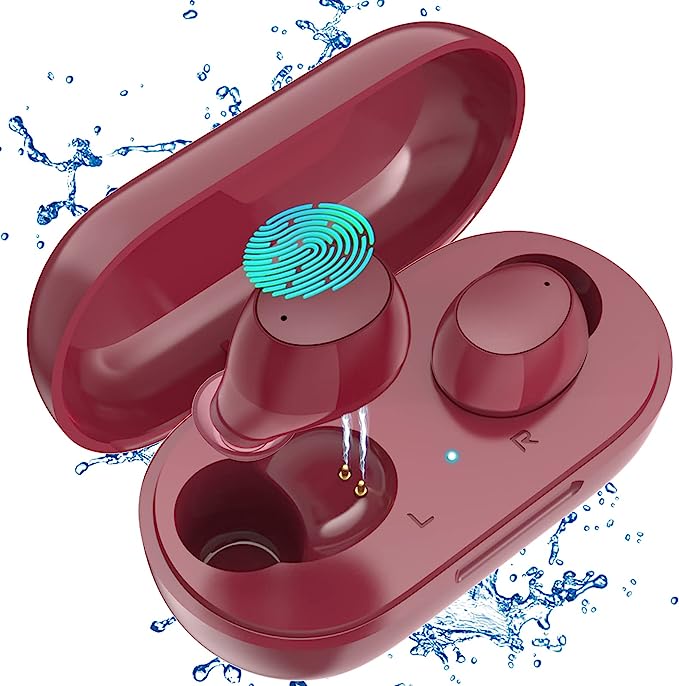Walk through any modern city, airport, or even just your local park, and you’ll see them – tiny pods nestled in ears, delivering music, podcasts, and calls without a single wire in sight. True Wireless Stereo (TWS) earbuds have transformed personal audio. Today, we’re going to dissect one such example, the Lanteso S21 Wireless Earbuds, not as a product review (we can’t really do that, as you’ll see), but as a case study to explore the science and engineering packed into these miniature marvels.
A Necessary Caveat Before We Begin: Our entire exploration today is based solely on the text provided from an Amazon product listing for the Lanteso S21 (in Burgundy). Crucially, this product is listed as “Currently unavailable,” and we don’t know if or when it might return. Furthermore, the listing shows only 19 customer ratings. This is a very small sample size. Therefore, please view this article not as an assessment of the S21’s actual performance or value, but as an educational journey into the types of technologies it claimed to possess, using the listing’s descriptions as our starting point. Think of it as looking at the blueprint of a house we can’t currently enter.

The Invisible Thread: Demystifying Bluetooth 5.2
The foundation of any wireless earbud is Bluetooth, the short-range wireless communication standard that acts like a digital handshake between your earbuds and your phone or computer. The Lanteso S21 listing specifies Bluetooth 5.2. What does that number actually mean in the grand scheme of wireless audio?
Each iteration of Bluetooth aims to improve upon the last. Compared to its predecessors (like Bluetooth 4.x or 5.0/5.1), Bluetooth 5.2, as a standard, was designed with several key goals in mind. Think of it like upgrading from an older radio transmitter to a newer, more sophisticated one. The potential benefits, which the S21 listing echoes in its claims of a “more stable connection, long transmission range with low power consumption and no latency,” generally targeted by the 5.2 standard include:
- Enhanced Stability & Efficiency: Engineers worked on improving how devices find and maintain connections, potentially leading to fewer annoying audio dropouts, even in crowded wireless environments. It also aimed for better power management, theoretically allowing devices to sip battery more efficiently.
- Improved Audio Capabilities: Bluetooth 5.2 introduced features like LE Isochronous Channels, paving the way for advancements like Bluetooth LE Audio (though we have no information if the S21 actually implemented LE Audio). These underlying changes aim to improve audio quality and enable features like broadcasting audio to multiple devices.
- Lower Latency Potential: Latency is that slight delay between something happening on your screen (like a character speaking in a video) and you hearing the corresponding sound. Newer Bluetooth versions work to minimize this delay, which is especially important for watching videos and playing games. The S21 listing specifically claims “no latency,” which is a very bold claim – minimal or low latency is usually the realistic goal.
It’s vital to remember that achieving these benefits in the real world depends heavily on both the transmitting device (your phone/computer) and the receiving device (the earbuds), as well as the surrounding environment. The S21 listing claims these advantages, leveraging the general advancements associated with the Bluetooth 5.2 standard.

Sound from a Speck: The Challenge of 6mm Drivers & Bass
How does something so small create sound, let alone the “Bass Sound” the S21 listing promotes? The magic happens within the 6mm aperture speaker drivers. A driver is the heart of any speaker or earphone – it’s an electromechanical transducer. In simple terms, it takes the electrical audio signal sent via Bluetooth and converts it into physical vibrations.
Imagine a tiny, incredibly precise drum skin (the diaphragm) inside each earbud. When the electrical signal hits it, this diaphragm vibrates back and forth rapidly, pushing the air around it and creating the sound waves that travel down your ear canal. The size of the driver (6mm in this case) dictates many of its acoustic properties.
Herein lies a fundamental challenge in audio engineering: producing deep, impactful bass frequencies typically requires moving a significant amount of air. Larger speaker cones do this easily, but a tiny 6mm diaphragm has physical limitations. Engineers employ clever acoustic designs within the earbud casing and precise tuning of the driver itself to maximize the bass response possible from such a small unit. The S21 listing claims “HD sound quality with deep bass, clear vocals, and crisp high tones” – this represents the target sound profile the engineers aimed for within the constraints of the 6mm driver and the earbud’s small enclosure. Achieving a balanced sound across all frequencies from a miniature driver is a delicate art.

True Freedom & Fingertip Control: TWS, Pairing, and Touch
The term “True Wireless Stereo” (TWS) signifies the complete absence of wires, not just between the earbuds and the source device, but between the two earbuds themselves. Each earbud acts as an independent receiver, offering unparalleled freedom of movement. The S21 embraces this, highlighting Auto Pairing.
How does this seemingly magical connection happen when you take them out of the case? It usually involves small sensors (magnetic or optical) detecting that the earbuds have been removed. This triggers the earbuds’ chips to power on and automatically initiate the Bluetooth pairing process, either reconnecting to the last paired device or entering pairing mode if no known device is nearby. The listing also mentions that either earbud can be connected separately, a common TWS feature allowing for mono listening or sharing.
Interaction is handled via Easy Touch Control. Instead of physical buttons, these earbuds likely use capacitive sensors embedded just beneath the outer surface. These sensors detect the change in electrical capacitance caused by your fingertip’s touch. Taps, holds, or swipes can then be interpreted as commands to perform actions like switching tracks, controlling volume, activating a voice assistant, or answering/ending calls, as claimed in the S21 description.

Wearing the Tech: Comfort, Fit, and a Question Mark on Water
For devices worn for potentially hours on end, comfort and fit are paramount. The S21 listing emphasizes an ultra-lightweight design, stating a single earbud weighs only 4.1 grams. To put that in perspective, a US nickel coin weighs 5 grams. This minimal mass, achieved through the use of lightweight polymers and compact internal components, directly translates to reduced pressure and inertia in the ear, significantly enhancing comfort during long listening sessions.
Beyond weight, the claimed Ergonomic design is crucial. The goal here is to shape the earbud housing to conform naturally to the contours of the average human ear canal and outer ear (concha). A good ergonomic fit serves multiple purposes:
* Comfort: Distributes pressure evenly.
* Stability: Helps the earbuds stay securely in place, especially important for the claimed suitability for sports and exercise.
* Acoustic Seal: Creates a snug fit that blocks out some external noise and, critically, allows the small drivers to deliver their intended sound, particularly bass frequencies which rely on this seal.
Now, about durability. The listing calls the S21 “Waterproof.” This term, however, is vague without a specific Ingress Protection (IP) rating (like IPX4, IPX7, etc.). Standardized IP ratings tell you precisely how much water exposure a device is designed to withstand (e.g., splashes, sweat, rain, or even submersion). The S21 listing provides no IP rating. Therefore, while it claims some level of water resistance, we have no reliable information on its actual ability to handle moisture. This is a significant unknown.
Juice for the Journey: Battery Life Claims vs. Reality Hints
Powering these tiny wireless devices presents another engineering puzzle. The solution is the now-standard two-part system: small batteries within each earbud and a larger battery within the charging case. The S21 listing claims 4 hours of continuous playtime on a single charge for the earbuds themselves. When depleted, placing them back in the mini designed portable charging box provides additional charges, bringing the claimed total battery life (with the case) to 24 hours (4 hours from buds + an extra 20 hours from the case).
It’s worth noting the user review section’s feature rating gives “Battery life” a score of 3.3 out of 5 stars (based on that small pool of 19 ratings). While anecdotal, this lower score might suggest that the real-world battery performance experienced by some users didn’t always align with the 4-hour claim per charge, which can be affected by volume level, connection stability, and feature usage.
Charging the case itself is done via a Type-C port, the modern, reversible USB standard offering convenience. The listing also mentions Fast Charging, claiming the case can be fully recharged in only 1 hour. Fast charging technologies work by allowing a higher rate of power flow into the battery (managed by dedicated circuitry in both the charger and the device) during the initial charging phases, significantly reducing downtime.
Can You Hear Me Now? The Potential of Four Microphones
Clear phone calls are increasingly expected from TWS earbuds. The S21 listing highlights “4 Mics Clear Calling.” This indicates that each earbud likely contains two microphones. Why multiple microphones?
The principle behind using multiple mics is to better distinguish the user’s voice from unwanted background noise. Sophisticated algorithms (which we don’t know if the S21 employs) can use the slightly different signals received by each microphone to:
* Form a beam: Electronically “focus” the listening direction towards the user’s mouth.
* Identify and suppress ambient noise: Use one or more mics to capture surrounding sounds and then subtract them from the voice signal captured by the primary mic.
Having four microphones provides the hardware potential for improved call clarity compared to single-mic designs. However, the actual performance heavily depends on the quality of the microphones themselves, their placement, and, crucially, the sophistication of the noise reduction algorithms running on the earbud’s chip. Achieving truly clear calls, especially in noisy or windy environments, remains one of the biggest challenges for these tiny devices. The “4 Mics” claim points to the hardware intended to tackle this, not a guarantee of flawless performance. Interestingly, one user review noted issues with the earbuds “changing volume by itself” and “skipping to the next song,” which could potentially relate to overly sensitive touch controls or perhaps even firmware glitches affecting audio processing or connectivity, though this is purely speculative.

Conclusion: Assembling the Puzzle & Final Thoughts
So, what have we learned by examining the blueprint of the Lanteso S21, as presented in its Amazon listing? We see the convergence of several key technologies that define modern TWS earbuds: the wireless foundation of Bluetooth (claimed 5.2) aiming for stability and efficiency, the miniature 6mm drivers tasked with producing sound within tight physical constraints, the TWS architecture enabling true wireless freedom and features like auto-pairing, the convenience of touch controls, the focus on lightweight (4.1g) and ergonomic design for comfort and fit, the dual battery system balancing playtime and portability with Type-C fast charging, and the inclusion of multiple microphones aiming for clearer calls.
However, our exploration must end with a strong reiteration of our initial caveat. This deep dive was based exclusively on promotional text from a single, now-inactive online retail listing with very limited user feedback. We lack independent verification, performance data, and crucial specifics like the actual waterproof rating. The product itself is currently unavailable. Reported user issues like erratic volume changes also remind us that specifications on paper don’t always translate perfectly to real-world user experience.
Ultimately, the Lanteso S21 listing serves as a snapshot of the features and claims common in the competitive landscape of affordable consumer electronics. It showcases the remarkable amount of technology packed into incredibly small packages, representing a complex balancing act between features, performance potential, cost, and the inevitable engineering compromises. Understanding the science behind the claims helps us become more informed consumers, better equipped to navigate the specifications and promises of the ever-evolving world of personal audio.




